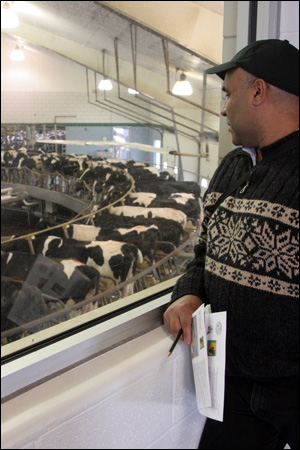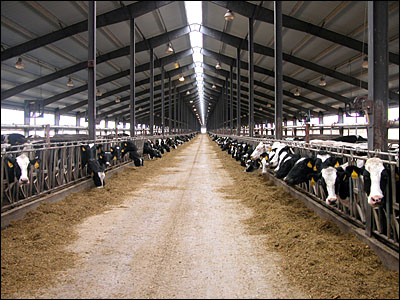|

Part: 1, 2, 3
The Manure Fix
As Tendris moves into the U.S. market, the Dutch company is running into competition from other groups with the same goal of making money on the fight against climate change. That includes Michael Gelobter and Chris Erikson and their Cooler credit card. As Cooler prepares to launch, Gelobter tells us he's learning from the mistakes of others: Cooler won't rely on tree planting for offsets.
"Trees have huge verification issues because there are so many variables involving land use and forest cover and things like that that are really not easy to control," says Gelobter. "It's not easy to be sure a stand of trees is going to be up the requisite 300 to 500 years it needs to be up to represent a real sequestration act. Tree planting is a great activity. It's just not been proven to reduce greenhouse gases in the atmosphere."

Michel Gelobter looking at the "merry-go-round" cow-milker. Photo by Carter Brooks
Instead, the company is looking for projects that stop greenhouse gases from being released in the first place. Recently, we caught up with Gelobter and the Cooler team at Holsum Dairies in central Wisconsin, as they investigate a creative approach to saving the planet.
In a huge barn, owner Ken Buelow shows Michel Gelobter the centerpiece of his dairy's highly mechanized operation: a rotating, circular platform that operates around the clock, milking 3,000 cows three times a day.
As Buelow demonstrates to the group, Holsum Dairies is doing more than just producing milk. Cow manure creates methane, a potent greenhouse gas. The dairy is capturing and storing that methane from the cow manure. Preventing the methane's release into the atmosphere earns the farm carbon credits. The farm then sells those credits on the booming global carbon market to power companies, big industries and, perhaps, retailers like Cooler. The deals flow through an offset company called Driving Green.
"If you look at a dairy farm, there is just a lot of manure. And so it creates the opportunity to capture that methane," says Duane Toenges, U.S. manager for Driving Green. As the man who buys and sells farmer Buelow's carbon credits, Toenges joins the group for the tour.
"The dairy we are visiting here today, at one time, the manure would have gone into a storage lagoon and methane is then emitted into the atmosphere," Toenges tells us. "What Driving Green does is we work with people to help them capture that methane. Because of the fact we can document that that methane was not emitted, we can sell it as an offset."
The group approaches a massive feed barn that runs the length of four football fields. Here, cows are chewing their cud to produce milk, and manure. The manure lands in a digester, speeding up the natural process in which bacteria decomposes manure and excretes methane. But here, the methane is captured rather than being released into the air. Then Holsum Dairies takes its environmental practices one step further by using the methane as fuel for an on-site electrical generator. "Our electricity goes out to the grid," Buelow explains. "It goes out to the power lines that feed electricity to all the homes and other farms in our area. So we sell it all back to the utility."
In a nearby calving barn, some twelve animals are born each day. As if on cue, a wet and steamy calf emerges from its mother, ready to begin anew the cycle of milk and manure. Buelow explains that the dried up solids from the processed manure are used for the new-born calf's bedding.
"This was manure 20 days ago," says Buelow, "before it went through the digester and separators."

Holsum Dairis in central Wisconsin.
Photo by Ellen Guettler
"It smells just like dirt," says Gelobter.
"We have gardeners that will come and put it right into their garden," says Buelow. "And we actually sell it to about seven other dairies for bedding as well."
"So you're basically making fuel off of it," says Gelobter, "and then using the stuff that's still left (for bedding)."
Toenges adds, "He's actually recycling the manure."
Holsum Dairies turns manure into energy, animal bedding and fertilizer, creating a closed loop ecosystem. This is important for Michael Gelobter because Cooler's success depends on building the customers' trust, trust that the operation doesn't have a social down-side.
"The folks who are going to be very interested in joining the Cooler system and making their purchases climate-neutral are going to be people who care about a lot of other things as well," Gelobter says. "They're going to care about the runoff to rivers (and) the way animals are treated."
But back at the dairy's office, farmer Ken Buelow reveals a possible snag in his operation. It turns out that his original motivation for capturing methane from manure had nothing to do with selling carbon credits.
Buelow tells us it was the electricity created from methane that made the operation economical. "So it was something we decided we needed to do before we realized we'd be able to sell carbon credits."
This is a key question for the carbon market known as "additionality." Is an operation like Buelow's providing an additional benefit to the environment? Climate scientist and Cooler advisor Dan Lashof says it's tempting to get paid for something you were going to do anyway.
"For example, improving the energy efficiency in a factory might be a good thing and that's an activity that helps the climate," he says. "But if the company was going to do that with or without the offset, then you haven't gotten an additional benefit from investing in the offset and therefore it can't really compensate for the emissions that you were trying to offset."
Duane Toenges, the broker who's paying the dairy and hoping to sell the carbon credits to Cooler, told us methane recapture is a legitimate offset. "If this dairy didn't capture methane, there would be methane going in the atmosphere," he says. "It's above and beyond any normal management practice is how it meets the additionality test."
Still, we're left with the question of whether so-called carbon offset companies are simply encouraging people to continue to consume guilt-free. Michel Gelobter, of Cooler, thinks the benefits outweigh the risks.
"We're not encouraging people to spend more," Gelobter says. "But at the end of the day, people have to buy things. There's nothing you spend money on that doesn't emit greenhouse gases, from life insurance to a cup of tea. So to say that by giving people a way to shop that reduces that impact would be a bad thing strikes me as burying your head in the sand."
Dan Lashof agrees with Gelobter. "There is a risk that some people could look at offsets as a way to get off the hook without changing their behavior," he says. "But hopefully in addition to buying offsets, it will encourage them to say, 'Well, I'm going to reduce my emissions directly by making sure that the next car I buy is much more efficient than the one I'm replacing.'"
So, does that mean that Duane Toenges, the carbon dealer, is ready to trade in his luxury Lexus for an energy-saving Prius?
"Not myself," he chuckles. "I'm one of these people that - first off, I'm going to ride in comfort. But at least I can offset the emissions from my car. Now, granted, we need to change our lifestyles a little bit, but there's only so much lifestyle change you can make."
That may well be the problem. Some researchers believe it will take a lot of lifestyle change to deal with global warming. Carbon offsets may be part of the solution. But there's a growing push for universal standards and even government regulations to insure that offsets actually help the environment. Both green credit cards, Cooler and ClimaCount, should be available to American shoppers soon. And they are among the untold new ventures hoping to make money while saving the earth.
| 
